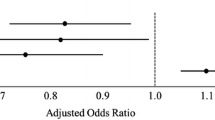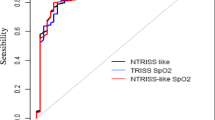Abstract
Background
Trauma-related mortality depends on injury severity. Several trauma scores are used to evaluate injury severity. We compared the Injury Severity Score (ISS) and the New Injury Severity Score (NISS) in terms of predicting mortality among hospitalized blunt trauma patients.
Methods
The data of Al-Ain Hospital Trauma Registry were prospectively collected over 3 years. Data of blunt trauma patients were then analyzed retrospectively. Univariate analysis was used to compare patients who died with those who survived. Sex, age, mechanism of injury, heart rate, systolic blood pressure (SBP), and Glasgow Coma Score (GSC) on arrival at the hospital, ISS, and NISS were studied. Significant factors were then entered into a direct likelihood ratio logistic regression model.
Results
Of 2,573 patients in the registry, 2,115 (82.2 %) suffered blunt trauma at a mean (SD) age of 32 (15.3) years. Among them, 1,838 (87 %) were male. Main mechanisms of injury were road traffic collision (vehicle occupants) (32.8 %) and falling from a height (22.4 %). Fifty patients (2.4 %) died. Univariate analysis showed that GCS and SBP at hospital arrival, ISS, NISS, and mechanism of injury significantly affected mortality. Logistic regression model showed that mortality was significantly increased by low GCS (p < 0.0001), high NISS (p < 0.0001), and low SBP (p = 0.006) at hospital arrival.
Conclusions
Mortality of blunt trauma in the UAE is significantly affected by high NISS, low GCS, and hypotension. NISS is better than ISS for predicting mortality of blunt trauma patients and may replace it.


Similar content being viewed by others
References
Morris JA Jr, MacKenzie EJ, Damiano AM et al (1990) Mortality in trauma patients: the interaction between host factors and severity. J Trauma 30:1476–1482
WHO (2010) Injuries and violence: the facts. http://whqlibdoc.who.int/publications/2010/9789241599375_eng.pdf. Accessed 23 Feb 2014
Fikri M, Noor AM, Shaheen H (2003) Preventive medicine department 2002 annual report. Ministry of Health, Abu-Dhabi
Champion HR, Sacco WJ, Carnazzo AJ et al (1981) Trauma score. Crit Care Med 9:672–676
Champion HR, Sacco WJ, Copes WS et al (1989) A revision of the trauma score. J Trauma 29:623–629
Jones JM, Skaga NO, Søvik S et al (2014) Norwegian survival prediction model in trauma: modelling effects of anatomic injury, acute physiology, age, and co-morbidity. Acta Anaesthesiol Scand 58:303–315
Moini M, Rezaishiraz H, Zafarghandi MR (2000) Characteristics and outcome of injured patients treated in urban trauma centers in Iran. J Trauma 48:503–507
Lavoie A, Moore L, LeSage N et al (2004) The New Injury Severity Score: a more accurate predictor of in-hospital mortality than the Injury Severity Score. J Trauma 56:1312–1320
Chawda MN, Hildebrand F, Pape HC et al (2004) Predicting outcome after multiple trauma: which scoring system? Injury 35:347–358
Osler T, Baker SP, Long W (1997) A modification of the Injury Severity Score that both improves accuracy and simplifies scoring. J Trauma 43:922–925
Whitaker IY, Gennari TD, Whitaker AL (2003) The difference between ISS and NISS in a series of trauma patients in Brazil. Annu Proc Assoc Adv Automot Med 47:301–309
LdeS Nogueira, CdeA Domingues, MdeA Campos et al (2008) Ten years of new injury severity score (NISS): is it a possible change? Rev Lat Am Enfermagem 16:314–319
Tay SY, Sloan EP, Zun L et al (2004) Comparison of the New Injury Severity Score and the Injury Severity Score. J Trauma 56:162–164
Zhao XG, Ma YF, Zhang M et al (2008) Comparison of the New Injury Severity Score and the Injury Severity Score in multiple trauma patients. Chin J Traumatol 11:368–371
Tamim H, Al Hazzouri AZ, Mahfoud Z et al (2008) The Injury Severity Score or the New Injury Severity Score for predicting mortality, intensive care unit admission and length of hospital stay: experience from a university hospital in a developing country. Injury 39:115–120
Hofman K, Primack A, Keusch G et al (2005) Addressing the growing burden of trauma and injury in low-and middle-income countries. Am J Public Health 95:13–17
Husum H, Strada G (2002) Injury Severity Score versus New Injury Severity Score for penetrating injuries. Prehosp Disaster Med 17:27–32
United Arab Emirates Census (2006) Population preliminary results 2005 by age and nationality. Adapted from: Preliminary results of the general census for population, housing and establishments, 2005. United Arab Emirates. http://www.zu.ac.ae/library/html/UAEInfo/documents/CensusResults2005.pdf. Accessed 27 May 2011
Shaban S, Ashour M, Bashir M et al (2009) The long term effects of early analysis of a trauma registry. World J Emerg Surg 4:42
Shaban S, Eid HO, Barka E et al (2010) Towards a national trauma registry for the United Arab Emirates. BMC Res Notes 3:187
Association for the Advancement of Automotive Medicine (1998) The Abbreviated Injury Scale 1990 revision—update 98. Association for the Advancement of Automotive Medicine, Barrington
Munro BH (2001) Selected nonparametric techniques. In: Munro BH (ed) Statistical methods for health care research, 4th edn. Lippincott, New York, pp 97–121
Sperandei S (2014) Understanding logistic regression analysis. Biochem Med (Zagreb) 24:12–18
Munro BH (2001) Logistic regression. In: Munro BH (ed) Statistical methods for health care research, 4th edn. Lippincott, New York, pp 283–302
Peduzzi P, Concato J, Feinstein AR et al (1995) Importance of events per independent variable in proportional hazards regression analysis. J Clin Epidemiol 48:1503–1510
Vittinghoff E, McCulloch CE (2007) Relaxing the rule of ten events per variable in logistic and Cox regression. Am J Epidemiol 165:710–718
Cook A, Weddle J, Baker S et al (2014) A comparison of the Injury Severity Score and the trauma mortality prediction model. J Trauma Acute Care Surg 76:47–52
WHO (2009) Global status report on road safety: time for action. http://whqlibdoc.who.int/publications/2009/9789241563840_eng.pdf/. Accessed 22 Dec 2013
Yan-Hong L, Rahim Y, Wei L et al (2006) Pattern of traffic injuries in Shanghai: implications for control. Int J Inj Control Saf Promot 13:217–225
Li YM, Hu SC, Fu CC (2006) Mortality from motor vehicle crash injuries in eastern Taiwan: a 5-year follow up study. Tzu Chin Med J 18:23–28
Eid HO, Abu-Zidan FM (2007) Biomechanics of road traffic collision injuries: clinician’s perspective. Singapore Med J 48:693–700
Abu-Zidan FM, Abbas AK, Hefny AF et al (2012) Effects of seat belt usage on injury pattern and outcome of vehicle occupants after road traffic collisions: prospective study. World J Surg 36:255–259. doi:10.1007/s00268-011-1386-y
Eid HO, Barss P, Adam SH et al (2009) Factors affecting anatomical region of injury, severity, and mortality for road trauma in a high-income developing country: lessons for prevention. Injury 40:703–707
Belzunegui T, Gradín C, Fortún M et al (2013) Major trauma registry of Navarre (Spain): the accuracy of different survival prediction models. Am J Emerg Med 31:1382–1388
ACS (2013) American College of Surgeons Committee on Trauma Leadership. In: Nance ML (ed) National Trauma Data Bank 2013 Annual Report. http://www.facs.org/trauma/ntdb/pdf/ntdb-annual-report-2013.pdf/. Accessed 6 Mar 2014
Haleem S, Lutchman L, Mayahi R et al (2008) Mortality following hip fracture: trends and geographical variations over the last 40 years. Injury 39:1157–1163
Kockelman KM, Kweon YJ (2002) Driver injury severity: an application of ordered probit models. Accid Anal Prev 34:313–321
Skaga NO, Eken T, Jones JM et al (2008) Different definitions of patient outcome: consequences for performance analysis in trauma. Injury 39:612–622
Bouamra O, Wrotchford A, Hollis S et al (2006) Outcome prediction in trauma. Injury 37:1092–1097
Bouamra O, Wrotchford A, Hollis S et al (2006) A new approach to outcome prediction in trauma: a comparison with the TRISS model. J Trauma 61:701–710
Ringdal KG, Coats TJ, Lefering R et al (2008) The Utstein template for uniform reporting of data following major trauma: a joint revision by SCANTEM, TARN, DGU-TR and RITG. Scand J Trauma Resusc Emerg Med 16:7
Acknowledgments
This study was supported by an Individual University Grant (# 01-07-8-11/03), Faculty of Medicine Research Grants (NP/03/11, 2003 and NP/04/28, 2004), and an Interdisciplinary Grant (#02-07-8-1/4).
Conflicts of interest
All authors declare that there are no conflicts of interest.
Author information
Authors and Affiliations
Corresponding author
Rights and permissions
About this article
Cite this article
Eid, H.O., Abu-Zidan, F.M. New Injury Severity Score Is a Better Predictor of Mortality for Blunt Trauma Patients Than the Injury Severity Score. World J Surg 39, 165–171 (2015). https://doi.org/10.1007/s00268-014-2745-2
Published:
Issue Date:
DOI: https://doi.org/10.1007/s00268-014-2745-2




